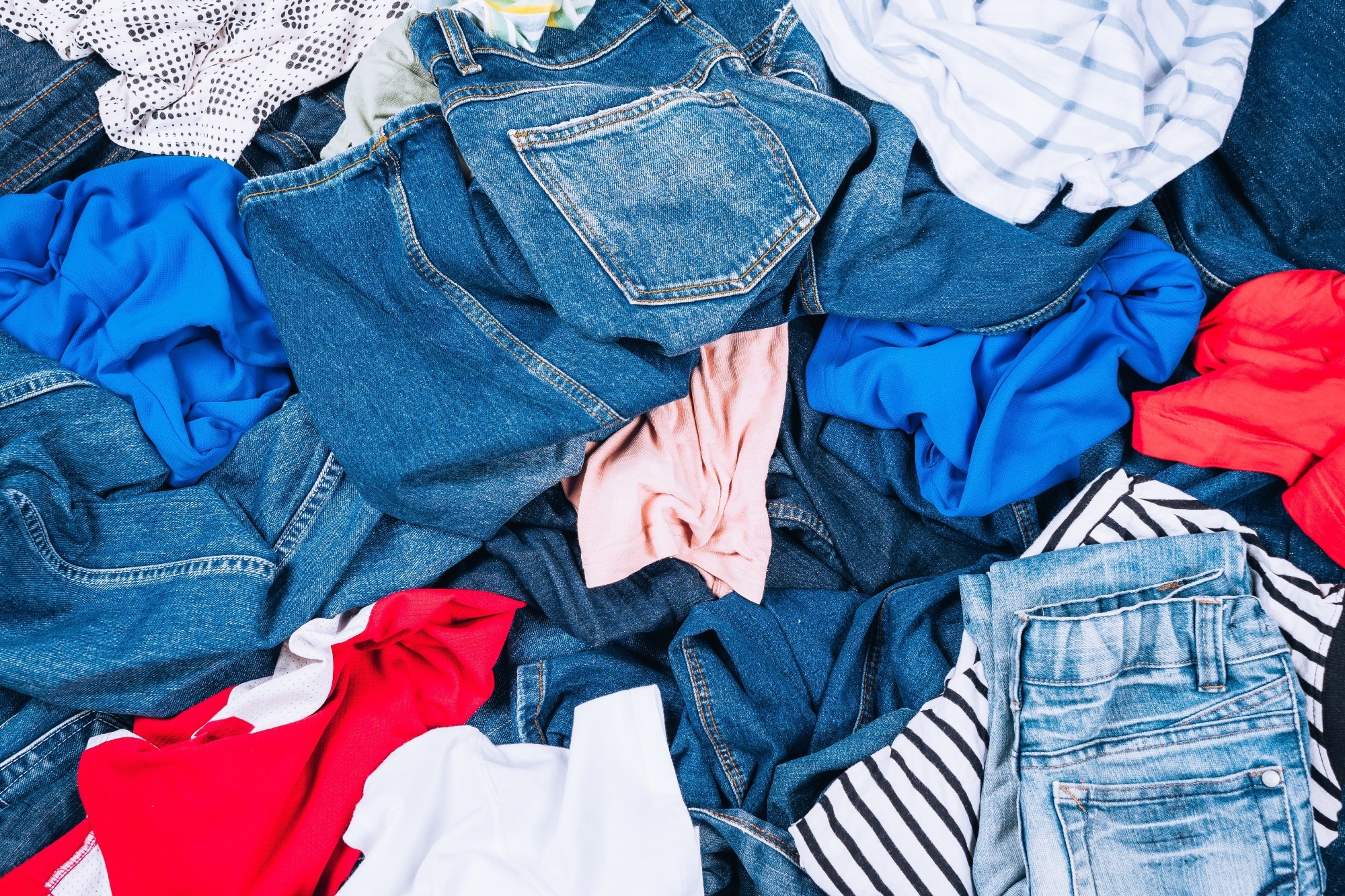A recent study published in ChemBioChem explores how ultraviolet-ozone (UVO) pretreatment can enhance the enzymatic breakdown of mixed cotton/polyethylene terephthalate (PET) textiles using PETase.
The research compares the performance of wild-type PETase (WT) and an improved mutant version (MUT S238F/W159H), and evaluates three pretreatment methods aimed at increasing enzyme accessibility: alkali treatment, UVO exposure, and natural sunlight weathering.

Image Credit: Veja/Shutterstock.com
Background
The environmental impact of textile consumption continues to grow, with less than half of used clothing collected for reuse, and only about 1 % recycled into new garments. Existing recycling methods, including mechanical and chemical approaches, are often energy-intensive and inefficient, particularly when dealing with blended fabrics.
Enzymatic recycling offers a more targeted solution by selectively breaking specific chemical bonds. However, effective PET degradation in textiles hinges on the enzyme’s ability to access those bonds. For post-consumer PET (especially in fabrics), polymer crystallinity can block enzyme interaction, making pretreatment a necessary step to boost enzymatic efficiency.
In this context, the study investigated how various pretreatment techniques impact PETase-mediated degradation of commercial cotton/PET blended textiles (35 % cotton/65 % PET). Researchers assessed the performance of WT and MUT PETase based on textile weight loss and the production of key PET degradation products: terephthalic acid (TPA) and mono-(2-hydroxyethyl) terephthalic acid (MHET).
Methods
The WT and MUT PETase enzymes were expressed in Escherichia coli and purified for experimental use. Enzyme concentrations were measured using spectrophotometry.
To test pretreatment methods, PET-cotton textile samples were immersed in 0.1, 1, and 10 M sodium hydroxide (NaOH) solutions for 24 hours at 30 °C with continuous shaking.
For UVO pretreatment, textile pieces were irradiated using a UVO cleaner emitting light at 253.7 nm with an irradiation power of 28–32 mW/cm2. Both sides of the scoured fabric were exposed for either 5 or 30 minutes, as well as for an extended period of 18 hours under an excimer lamp.
In the UV sunlight pretreatment condition, textile samples were placed outdoors under natural environmental exposure for up to three summer months in Castellón, Spain.
Following pretreatment, both untreated and treated textile samples were incubated in a 50 mM glycine-NaOH buffer (pH 9.0) containing purified PETase (2 mg enzyme per gram of PET) at either 30 °C or 40 °C for durations ranging from 1 to 14 days. After incubation, the textile samples were thoroughly rinsed with distilled water, vacuum-dried at 40 °C for 20 hours, and then weighed to assess material loss due to degradation.
Surface and chemical changes were analyzed using Fourier-transform infrared (FTIR) spectroscopy and scanning electron microscopy. The surrounding solution was examined with high-performance liquid chromatography (HPLC) and nuclear magnetic resonance (NMR) spectroscopy to quantify PET degradation products.
Results and Discussion
Alkali treatment led to non-specific degradation of both PET and cotton components in the textile samples, resulting in noticeable weight loss but offering little improvement in enzymatic selectivity.
The limited effectiveness of NaOH in breaking down the polymers was likely due to the moderate processing temperature (30 °C), which helped preserve overall textile structure while allowing for some chemical alteration.
In contrast, UVO treatment, while also causing some non-specific weight reduction, significantly enhanced PETase activity in a synergistic way.
The duration of UVO exposure played a key role in shaping the degradation outcomes: extended exposure (18 hours) led to nearly complete depolymerization to terephthalic acid (TPA), whereas shorter exposure (30 minutes) primarily produced mono-(2-hydroxyethyl) terephthalic acid (MHET). This time-dependent shift in degradation products suggests a promising level of control over PET breakdown pathways.
Textile samples exposed to natural environmental conditions for three months showed only minimal improvement in WT PETase activity, and a slight decrease in performance for the MUT PETase variant. This occurred despite clear visible changes to the textile surface.
FTIR analysis indicated that sunlight exposure may preferentially alter cotton over PET, pointing to the influence of fiber-specific photodegradation processes in environmental conditions.
The study also revealed distinct differences in the degradation products generated by WT and MUT PETase, highlighting the potential for engineering enzymes with customized functions for specific recycling needs.
Among the pretreatment methods evaluated, UVO stood out as the most effective. Thanks to the combined effects of ultraviolet light and ozone, it enhanced PETase-mediated degradation through improved accessibility and enzymatic activity.
Download your PDF copy now!
Conclusion
This study provides a detailed look at how different pretreatment strategies affect enzymatic PET degradation in blended textile materials. Alkali, UVO, and natural sunlight exposures were shown to trigger distinct chemical and structural changes that influence enzymatic performance.
Of the methods tested, UVO pretreatment offered the most significant boost to PETase activity, likely due to its ability to alter the PET surface in ways that promote enzyme accessibility.
These findings support further exploration of UVO as a scalable, energy-efficient pretreatment technique, not just for textiles, but potentially for broader plastic waste recycling as well.
Continued research is needed to understand the underlying chemical mechanisms of these pretreatments and refine the process for industrial use. Controlling PET degradation pathways using light-based pretreatment could play a significant role in addressing textile waste and plastic pollution in a more sustainable way.
Journal Reference
Sariah Giraldo-Narcizo, Guerrero, A., SANCHEZ-PEREZ, A. maria. (2025). Ultraviolet Ozone Pretreatment Enhances selective PETase Biodegradation of Textiles Compared to Sunlight and Alkali Treatments. ChemBioChem. DOI: 10.1002/cbic.202500004, https://chemistry-europe.onlinelibrary.wiley.com/doi/epdf/10.1002/cbic.202500004
Disclaimer: The views expressed here are those of the author expressed in their private capacity and do not necessarily represent the views of AZoM.com Limited T/A AZoNetwork the owner and operator of this website. This disclaimer forms part of the Terms and conditions of use of this website.